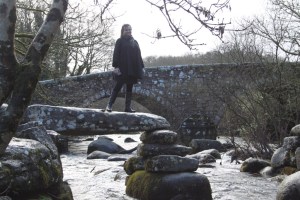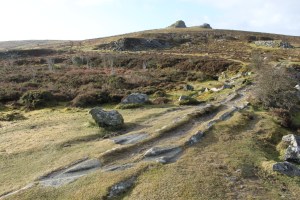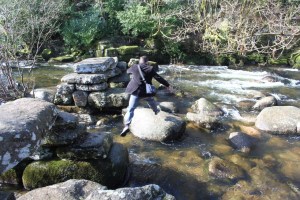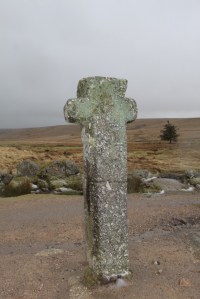This is a reblog from Howard Williams’s Archaeodeath blog.
Over the last decade, there was a long-running oral history project recording ‘moor memories’ on Dartmoor. In this blog I wish to talk about different kinds of ‘moor memories’ beyond the personal recollections of its recent inhabitants. I wish to consider how archaeology and literature reveal the complex and varied uses of material culture, monuments and places, including natural features, in the creation and reproduction of social memories over the long term for communities inhabiting Dartmoor in the prehistoric and historic past. Part of this relates to memories of the dead as well as memories of the living.
Dartmoor is one of the most archaeologically potent zones of the English landscape in two ways. First, Dartmoor is rich in surviving traces of prehistoric, medieval and post-medieval human activity. Prehistoric remains include stone rows and circles and cairns, hut circles, coaxial field systems and the famous Dartmoor reeves (long linear boundaries demarcating large sections of the moors and their field systems). Medieval and post-medieval remains including deserted farms and their field systems, wayside and boundary crosses, traces of quarrying for copper, lead, stone and (in particular) extensive evidence for tin mining and smelting.
Second, Dartmoor is potent for the long tradition of close interaction between archaeology, folkore and literature, both in terms of academic research and popular reception. This might be encapsulated in the Victorian clergyman and scholar, Sabine Baring-Gould, whose interest in Dartmoor’s folklore and archaeology led to the first excavations at Grimespound. With regard to popular reception, one only has to recall the inspiration of the folklore, archaeology and landscape on Conan Doyle’s The Hound of the Baskervilles. There are many more examples including place-names that must have been coined to reflect the stories and associations of Dartmoor’s medieval inhabitants.
Despite this archaeological richness, current approaches to the archaeology of Dartmoor remain memory-free in terms of how they interpret archaeological remains and present them to the public. Some categories of archaeological material might be seen as ‘funerary’ or ‘ritual’, others relate to ‘settlement’ and land division. Many recognise the rich ‘palimpsest’ of the Dartmoor landscape. Still, it is rare for these traces of past lives and past deaths to be approached with regard to social memory. Indeed, while some prehistorians have engaged with this theme, the full range of archaeological data, from prehistory to the contemporary past, rarely gets considered in relation to memory work – the practices and technologies by which memories are created, transmitted and reproduced.
Perhaps the reluctance lies in the long struggle to disentangle archaeology from myth and legend that is replete in the landscape and led in some antiquarian writings to the attribution of many natural features to human manufacture. Perhaps it is also the result of a long-established discourse to use the landscape of Dartmoor to write landscape history – an aspiration towards objective narrative regarding what people did in the past – not how, what and why they remembered and forgot their past through inhabiting and transforming the landscape… and talking about it.
Still, in the ongoing project The Past in its Place, we hope to use a segment of Dartmoor to explore the relationship between memory and landscape through the intersection of literature and archaeology. We take as our inspiration important work on the archaeology of folklore conducted in the SW of England and elsewhere, and work on the prehistoric of Dartmoor in particular that has engaged with the temporality of landscape.
Last week, I made a preliminary expedition to a few sites that touch on our theme, and in particular, how at different times, the medium of stone is itself the mechanism for the composition and iteration of social memories.
Dartmoor has so many exciting sites to see and is such a variegated landscape, that nowhere is ‘typical’. In only half a day, there was only time to see a small fraction of the sites I would have wished. Still, I wanted, in only half a day, to show my colleagues Dr Naomi Howell (University of Exeter) and Dr Patricia Murrieta-Flores (University of Chester) some different dimensions to it, both in terms of archaeological remains and in terms of topography, tied to literature in some instances, and tied to memory work through the medium of stone. I made a decision to, in this particular trip, avoid the prehistoric evidence that dominates discussions of Dartmoor’s archaeology and instead look at the more recent past and its traces of memory work. I want to here focus on the relationship between movement, inscription and memory, and how stone in particular – but not exclusively – is used to mobilise this relationship.
Movement and memory are key to understanding the archaeology of memory on Dartmoor, and stone often constitutes the medium for the relationship between them. From prehistoric tracks and field boundaries to the tramways that hauled stone off the moors, memory and movement are intrinsically linked in the landscape.
First up, we went to Haytor – to explore this most visited of tors upon the moor, and to consider its industrial landscape – stone quarries and tramways. The tramways fascinate me. Not only are the quarries and tramways ‘memories’ of an abandoned industry left clearly inscribed on the land, they demand negotiation and engagement through movement along and around them. Haytor also interests me since, in terms of memorial culture, the last stones quarried here were taken to provide stone for the Devon and Exeter War Memorial in Northernhay Gardens, Exeter. Stone is here a medium for commemoration, not only for its enduring qualities, but the ‘sacredness’ of its origin – the ‘heart’ of Devon.
Next, we walked the parish boundary between Buckland and Ashburton parishes to Buckland Beacon. We noted how 1837 boundary marks and field boundaries defined the parochial division, another relationship between memory and movement, marking the boundary and marking movement along it, as well as commemorating the act of its redefinition. Each stone had the date of its construction and, upon its sides, the initials ‘A’ for Ashburton and ‘B’ for Buckland. Thus, the boundary served to demarcate, but also to facilitate how to navigate, the landscape.
Then we went through Widdicombe to Dartmeet. Above Dartmeet with encountered the Coffin Stone where folklore has it, coffins en route to Widdicombe church were rested. It was smote in two by lightning to punish and destroy the coffin and corpse of a sinner rested on it. The stone is inscribed with initials of the dead and crosses commemorating those that passed by after they had passed away.
At Dartmeet we identified a further physical trace of memory and movement – a half-surviving clapper bridge – once used routinely to convey pack-horses laden with tin and other materials off the moor. I made my bid for freedom by jumping across to the surviving central section. Nothing went wrong, despite my best efforts….
Finally, we walked along an ancient trackway to the Nun’s Cross (yes, it was a medieval granite-hewn cross, not an angry woman in a wimple). Otherwise known as Siwards Cross, this striking monument is a waymarker situated at an intersection of medieval routes across the moor. Here we encountered the wrath of Dartmoor’s weather as the second we reached the cross – near-horizontal sleet. Still, in the darkness and cold of that deluge, we realised the value of the stone as shelter and for navigation in the difficult and barren terrain.
Inscribing and Depositing Memories
Relating to the relationship between movement and memory, we found in our short visit a range of means by which memories are inscribed upon the landscape in stone. A clear example of the link was provided in our visit to Haytor. Close to the tor is a tree that seems to be regularly used to memorialise the recent dead, not through textual memorials, but through ash scattering and ribbon tying. This tree is public and private – right next to one of the most visiting sites on Dartmoor, and yet secluded and special. This is a common way of memorialising through association with beauty spots.
Next, we went to Buckland Beacon which bears two striking inscriptions. First is the Ten Commandments Stone – actually two stones – bearing an inscription of the Ten Commandments plus other biblical inscriptions, situated in a striking location with views south over the edge of Dartmoor. The stones were inscribed in 1928 and relate to a particularly idiosyncratic turn of events relating to faith and the recent British landscape. A second inscription is a patriotic one, commemorating the silver jubilee of King George V and the use of the Beacon as a part of a chain of fires to commemorate the event. The site was the focus of more recent beacons, including QE2’s diamond jubilee. We also found deposition here – two caches – one a Flora margarine pot, one a tupperware container – each with notebooks and the memories/statements/names of those who had visited. The latter also had a collection of artefacts left by visitors – the paraphernalia of geocaching.
A further successive inscriptions, again linked to routes of movement, were found near Widdicombe. Here at a fork in the road (careful I said, forks in the road can puncture your tyres) are two memorials to commemorate our glorious QEII: first a stone raised as a megalithic memorial to the Silver Jubilee in 1977, the second a megalithic memorial to the Diamond Jubilee of 2012.
Of course the Coffin Stone also links movement and memory to inscription, since initials of those mourned were inscribed upon the stone, together with crosses. And finally, the Nun’s Cross has text inscribed upon it. Difficult to read in the poor light and sleet, does the name ‘Siward’ inscribed upon it commemorate history or myth? Was this a Saxon cross or one that imagines a Saxon past through this inscription?
What is interesting is the relationship between text and granite – the hardest of rocks to inscribe. Most of the texts discussed here were near-invisible, revealing the relatively ephemeral nature of text as a medium of commmoration in this kind of rugged stoney landscape. Yet the monumental medium of stone means that text is always only part of the story. Tied to the places where it is inscribed, the act of inscribing, or depositing, is more important, or as important, as the legibility of what is cut or placed.
These examples suffice to illustrate the varied ways in which movement, inscription and deposition have proven strategies of remembrance in Dartmoor’s late-historic landscape, linked to stories about the living and stories about the dead. I hope to report on more moor memories in future blogs, including those of prehistoric and medieval origin.

















